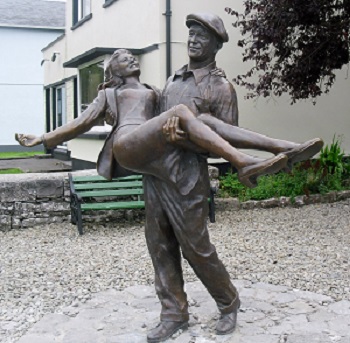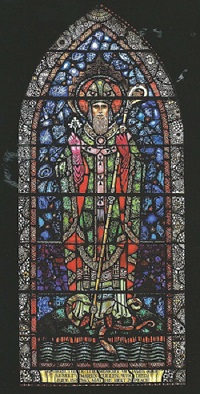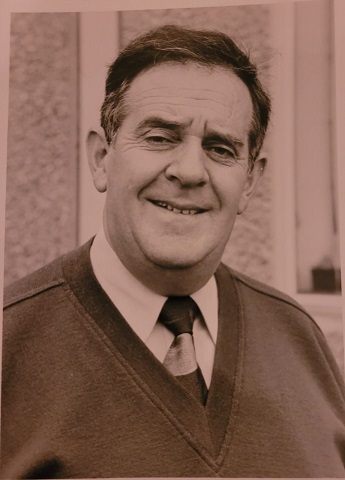
John Wayne and Maureen O’Hara sculpture by Mark Rode in Cong, County Mayo.Mark Rode (born 1965) is a distinguished figurative sculptor, whose work can be seen in several Irish counties, especially in County Mayo. His speciality is creating a perfectly modelled figure in bronze, with empathy, subtlety, and a desire to connect with viewers. After studying art, anatomy, proportion, and bronze-casting in his native Australia, he moved to Europe in 1998, and gained experience in England, France, Italy, and Germany before settling in Ireland with his Irish wife, Jacinta Guinan. They eventually took up residence in Killasser, Swinford, County Mayo where his business is located.
One of his early Irish figures was the Brother Walfrid sculpture in Ballymote, County Sligo. It was unveiled on October 24, 2004, to honour Andrew Kerins (1840-1915), a native of Cartron Phibbs, Ballymote, who emigrated to Glasgow and later joined the Marist order, taking the name Brother Walfrid. He became the founder of Glasgow Celtic Football Club on November 6, 1888, which became the most successful sporting institution of the Irish diaspora, winning the European Cup in 1967. Mark’s other early public work include the Mayo County Crest, Castlebar (2005), Leaping Salmon, Foxford (2005), as well as Man Reading Newspaper and Man with Suitcase, Kiltimagh (2006), both with artist Sally McKenna, the Jim McPadden Memorial in Leitrim (2006) In co-operation with Tim Morris, Mark Rode was the sculptor of a woman and child from the 1950s entitled Strength of a Woman, donated to Swinford in 2007 to remember the women who looked after their homes and families while their men worked in England.
One of his best known Irish public sculptures is the Champions in Tralee, County Kerry. Four metres in height, it depicts four footballers jumping for a ball, and was commissioned by Kerry County Council to celebrate the county’s long and proud tradition in Gaelic footballa Over a tonne of bronze was used in this spectacular sculpture, which was unveiled in Tralee on May 14, 2007. He did the Tour de France Memorial in Enniscorthy, County Wexford (2008), and the All-Ireland hurler in Birr, County Offaly, in 2009. The bronze statues and ship bow in the Addergoole Titanic Memorial Park in Lahardaun, County Mayo, are the work of Mark Rode. The park was opened on April 12, 2012, to remember the centenary of the sinking of the Titanic on April 14, 1912, with twelve local people on board, eleven of whom perished. Mark did the Marish Brother in Athlone in 2012.
Mark’s sculpture of John Wayne and Maureen O’Hara, who played the roles of Sean Thornton and the feisty Mary Kate Danaher in The Quiet Man film in 1951, was unveiled in Cong, County Mayo in October 2013. He did the Thomas McDonagh Sculpture in Cloughjordan, County Tipperary (2016), one of the seven leaders of the Easter 1916 Rising, who was born there. In 2018, Mark’s sculptures of President Barack and First Lady Michelle Obama were unveiled at the Barack Obama Plaza, a popular service station at Moneygall, County Offaly, at junction 23 on the M7 Dublin to Limerick Motorway. Moneygall was the ancestral home of a maternal great-great-great grandfather of the forty-fourth President of the United States, who visited the village in 2011.
Mark’s most recent work was a sculpture of Grace Kelly (1929-1982), who won an Oscar for her role The Country Girl in 1954 and a year later married Prince Rainier of Monaco, was unveiled in Newport, County Mayo, in 2023. Her paternal grandfather, John Kelly, came from near Newport. In January 2024, his sculpture of Grace O’Malley, was also unveiled in Newport. She was the pirate queen along the wild Atlantic coast of Connacht during the second half of the sixteenth-century, and lived for some time in Rockfleet Castle, near Newport. In addition to his public sculptures, Mark Rode has exhibited his work in galleries in Australia, England and several venues around Ireland. His sculptures are held in many public and private collections in Ireland, Australia and the United Kingdom.


